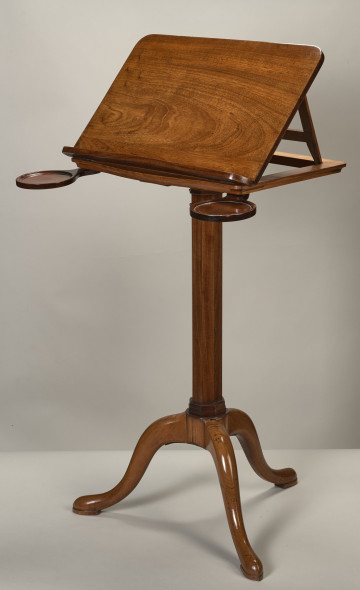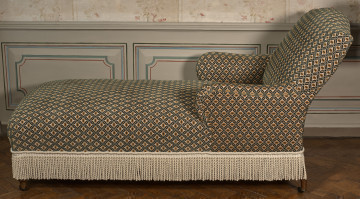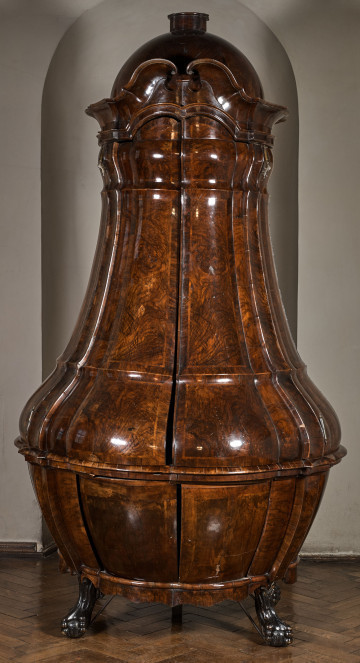
Wooden desktop
18th-19th century
Castle Museum in Łańcut
Part of the collection: Meble i wyposażenie wnętrz
One piece of furniture, used in France since the mid-18th century, is the chiffonier. It is a small, narrow, high chest of drawers used for storing undergarments, small ornaments, women’s clothing accessories, fabrics, personal items, papers, and jewellery. Its name comes from the French chiffon meaning canvas, a small piece of cloth, a rag. The presented classicist chiffonier was made together with another identical piece of furniture (S.7791MŁ; S.7792MŁ). According to the previous owners, the two chests of drawers, purchased by the Castle Museum in 1960, came from the Petit Trianon palace in the gardens of Versailles, which was a favourite of Queen Marie Antoinette. The white marble plaques on the front of each drawer of the mahogany veneered piece of furniture are eye-catching. Two smaller circular plaques serve as the background for the bronze cast handles. The central oval ones form the background for medallions with portrait busts. The reliefs, imitating ancient cameos, were made and signed by the English firm of Wedgwood & Bentley, operating between 1769 and 1780, at the Etruria factory in the Stoke-on-Trent area of central England. Thanks to Josiah Wedgwood’s experiments, the production of stoneware coloured with metal oxides and not requiring glazing, known as jasper stoneware, began in the 1870s. These were products with a light-coloured mass forming the background for the white relief art. The author of the white and blue medallions mounted on the chiffonier is John Flaxman, a modeller working for Josiah Wedgwood between 1775 and 1787. The medallions depict, in right profile: the playwright Jean-Baptiste Racine; the writer, historian and philosopher Jean-François Marmontel; the poet and literary critic Nicolas Boileau-Despréaux (according to an illustration by Charles Nicolas Cochin – creator of more than 300 images of famous Frenchmen); the writer, theatre critic and philosopher Denis Diderot (alternatively, the writer and philosopher Montesquieu, or Charles Louis de Secondat, Baron de La Brède et de Montesquieu).
Author / creator
Dimensions
height: 93 cm, width: 47 cm
Object type
Furniture and interior fittings
Technique
inlaying
Material
bronze, wood, biscuit
Creation time / dating
Creation / finding place
Owner
Castle Museum in Łańcut
Identification number
Location / status

18th-19th century
Castle Museum in Łańcut

20th century
Castle Museum in Łańcut

18th century
Castle Museum in Łańcut
DISCOVER this TOPIC
Museum of King Jan III's Palace at Wilanów
DISCOVER this PATH
Educational path